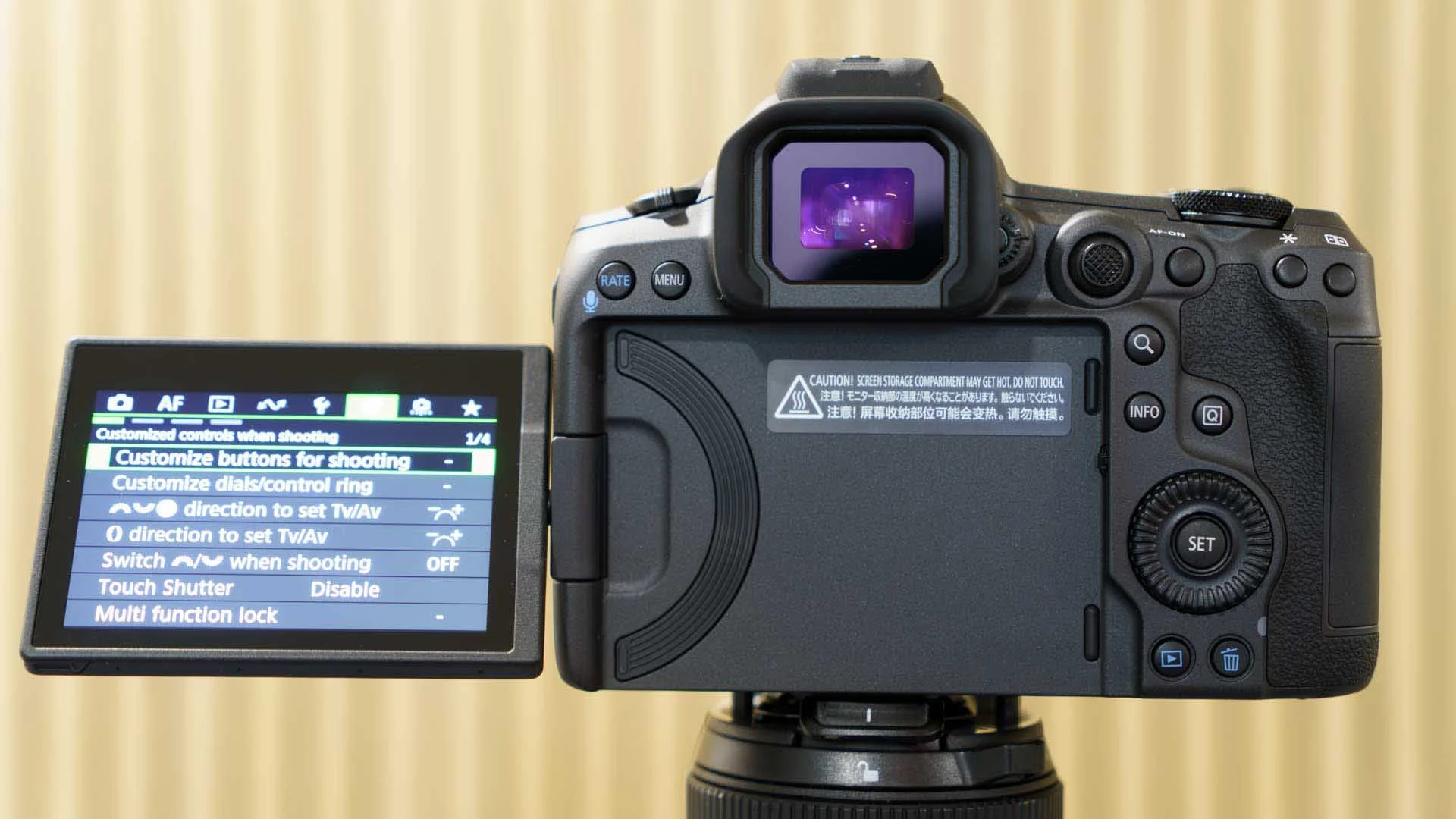Canon EOS R5 Mark II vs Canon EOS R5
The Canon R5 was announced on 9th July 2020 along with the Canon R6. The two camera put Canon right at the forefront of the mirrorless camera market. Now, almost exactly four years later, the Canon R5 II has been announced, building on what came before, incorporating some features first seen in the Canon R3 and introducing some new technology. Nevertheless, there are quite a few similarities between the R5 Mark II and the R5. In this post, I’ll compare the Canon R5 II with the R5 to identify the key differences between them and see how they shape up.
Sensor
Canon R5 II: 45MP Full-frame stacked BSI CMOS
Canon R5: 45MP Full-frame CMOS
While the two cameras have the same pixel count they use different sensors and the R5 II’s chip is more sophisticated. The stacked, backside-illuminated (BSI) structure of the R5 II’s sensor allows its pixels to be a little bit larger than the original R5’s. It also facilitates faster readout speed which is good news for the autofocus system, employing complex algorithms and all-round responsiveness.
Although the two cameras have the same resolution, the Canon R5 II has in-camera upscaling that enables images to be increased in size by up to 4x. That means you can create 179MP images if you want. This can also be combined with in-camera cropping if you want to zoom in on a subject.
Read our Canon EOS R6 II Review
Processor
Canon R5 II: Digic X and Digic Accelerator
Canon R5: Digic X
In addition to the latest version of Canon’s Digic X processor, the R5 Mark II has a second processing engine called Digic Accelerator. The combination of these two processors and the new sensor enables what Canon is calling ‘Accelerated Capture’, its fastest image processing platform to date. It enables the R5 II to shoot continuously at up to 30 frames per second (fps) when its electronic shutter is in use, that’s 10fps faster than the original Canon R5. Of course, 20fps is more than enough for many situations, but there could be the odd occasion when shooting at 30fps makes a significant difference.
While the R5 II can maintain that 30fps rate for up to 200 Jpegs or 93 raw files, the R5 can shoot at 20fps for up to 350 Jpegs or 180 raw images. The R5’s deeper burst depth could be useful, but keep in mind that the R5 II’s continuous shooting rate can be reined in to 20, 15, 12, 10, 7.5, 5, 3, 2 or 1 fps, which will extend its burst depth.
Unlike the R5, the R5 II has a Pre-continuous shooting mode which enables you to capture up to 15 images from the moment before the shutter button is pressed home. That could be useful for wildlife photographers waiting for a bird or animal to move.
The Canon R5 II seen here looks very similar to the original R5.
Autofocus system
Canon R5 II: Dual Pixel Intelligent AF with Dual Pixel Intelligent AF with subject detection for Humans (Eyes, Face, Head, Upper half of body, Body), Animals (Dogs, Cats, Birds and Horses) or Vehicles (Racing cars or Motorbikes, Airplanes and Trains), Register People Priority (up to 10 x 10 registered people), Action Priority (Football, Basketball, Volleyball)
Canon R5: Dual Pixel AF II with subject detection for Humans, Animals (Dogs, Cats and Birds) or Vehicles (Racing cars or Motorbikes), with Eye detection for humans and animals.
New algorithms enable the R5 II to detect and track a wider range of subjects with greater precision. In addition, Register People Priority enables it to prioritise specific people for focusing while Action Priority mode sets the camera to focus on players making specific moves in football (soccer), basketball and volleyball, making it easier than every to capture a dynamic game.
The R5 II’s AF system is also more sensitive than the R5’s as it can focus in light down to -6.5EV rather than -6EV. That’s good news for low-light photography.
Video
Canon R5 II: 8K 60p raw in-camera, 4K 120p and 4K oversampled from 8K, C-Log 2 and C-Log3
Canon R5: 8K 30P raw in-camera, 4K 120p and 4K oversampled from 8K, C-Log 3
Both cameras offer some powerful video features but the R5 II wins here with its ability to capture 8K video at up to 60p for up to 120 minutes. The R5 can only muster 8K at 30p for 20 minutes because of overheating.
It’s also worth mentioning that the R5 II can capture stills and video simultaneously, whereas the R5 can’t.
The Canon R5’s power switch is on the left of the top-plate
Build
Canon R5 II: (WxHxD): 138.5 x 101.2 x 93.5mm, 656g body only, 746g with a memory card and battery
Canon R5: (WxHxD): 135.8 x 97.5 x 88mm, 650g, body only, 738g with a memory card and battery
As the figures above show, the R5 II is only about 6g heavier than the R5. It’s very unlikely that anyone will be able to tell the difference between them. In fact, that difference could easily be absorbed by a change of strap.
The new camera is also a little beefier, but it doesn’t make a dramatic difference in your hand.
Canon has made a couple of control layout changes for the R5 II compared to the R5. Where the power switch is on the R5, the R5 II has a photo/video switch. Consequently, the R5 II has a new power switch in front of the mode button and its surrounding dial. This arrangement will be familiar to and Canon R6 II users.
The Canon R5 II and R5 are both made from magnesium alloy and have a similar level of weather resistance.
The power switch on Canon R5 II on the right side of the camera’s top-plate, near the mode button.
Stabilisation
Canon R5 II: Up to 8.5EV
Canon R5: Up to 8EV
There’s not a huge amount to separate the cameras here, but when paired with a stabilised lens, the R5 II should enable you to shoot hand-held at slightly slower shutter speeds and still get sharp images.
The place occupied by the power switch on the R5 is the photo/video switch on the Canon R5 II.
Viewfinder and screen
Canon R5 II: 0.5-inch 5.76-million-dot electronic viewfinder, 3.2-inch 2.1-million dot vari-angle touchscreen
Canon R5: 0.5-inch 5.76-million-dot electronic viewfinder, 3.2-inch 2.1-million dot vari-angle touchscreen
Although the viewfinders on the two camera look quite different, they are the same size and resolution. However, the R5 II’s viewfinder is twice as bright as the R5’s, which should make it more comfortable to use in bright conditions.
The R5 II’s viewfinder looks different from the R5’s because it incorporates Eye Control AF technology. This enables you to select the subject for focusing with your eye rather than having to nudge the joystick. It takes a bit of getting used to and may not be ideal for every situation, but it can be turned off and gives you a speed advantage in some situations.
Canon EOS R5 Mark II. The two cameras have the same 3.2-inch 2.1-million dot vari-angle touchscreen which can be flipped out for easier viewing above or below hed-height in landscape or portrait orientation.
Battery
Canon R5 II: LP-E6P - 630 shots using the screen and 340 shots using the viewfinder
Canon R5: LP-E6NH - 490 shots using the screen and 320 shots using the viewfinder
Although the R5 II comes with a new LP-E6P battery, it can accept the older LP-E6NH, However, it’s important to note that some of high-level burst shooting and video features will be limited or disabled if the new LP-E6P isn’t used.
As the figures above show, the LP-E6P battery has a significantly longer life when the screen is used to compose images. It seems that a brighter viewfinder consumes a lot of power.
Unlike the Canon R%, the Canon R5 II shown here has a full-size HDMI port.
Connections
Canon R5 II: Full-size HDMI, USB-C 3.1 Gen 2, Wireless LAN (IEEE 802.11ax 2×2 MIMO) (6 GHz / 5 GHz / 2.4 GHz)23, with Bluetooth 5.3 support, mic and headphone socket, remote control socket, PC sync socket
Canon R5: Micro HDMI, USB-C 3.1 Gen 2, (IEEE802.11a/b/g/n/AC) (5Ghz /2.4 GHz), with Bluetooth 4.2 support, mic and headphone socket, remote control socket, PC sync socket
A key difference here is that the R5 II has a full-size HDMI port rather than a micro HDMI port, which many videographers will appreciate when connecting an external recorder or monitor to the new camera. In addition, the R5 II has faster USB-C and Wi-Fi connectivity.
Unlike the R5 which has a regular hotshoe for mounting a flashgun or wireless trigger, the R5 II has a 21-pin multifunction shoe which enables more powerful communication with a wider range of accessories including flash units, microphones and transmitters. The Multi-Function Shoe Adapter (AD-E!) is sold separately to enable older accessories to be used on the R5 II.
Canon EOS R5 Mark II vs R5, should I upgrade?
There’s plenty more testing to be done on the Canon R5 Mark II, but so far it looks like an excellent successor to the popular Canon R5. While the resolution of the two cameras is the same, the R5 II has a more modern sensor, improved autofocus capability and some exciting new features that draw on artificial intelligence and deep learning to help photographers and videographers get the shots they want. Although the Canon R5 II has the same sensitivity (ISO) range as the Canon R5 (ISO 100-51,200 expandable to ISO 50-102,400) the new sensor and processors may enable it to produce cleaner high ISO images. That’s something I will look into when a full-production review sample becomes available.
Based on what we have seen so far, if your primary interests are sports, action, or wildlife photography, it looks like it's worth upgrading from the original Canon R5 to the Canon R5 II. If you’re into landscape, still life, or macro photography, I’d hold out for now until we learn more about the R5 II's dynamic range and can test the upscaling function.







